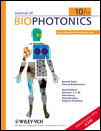Light-guided lumpectomy: first clinical experience
Abstract
Despite numerous advances, lumpectomy remains a challenging procedure. We report on the early use of light-guided lumpectomy. Eight patients with non-palpable breast cancer undergoing lumpectomy for biopsy-proven and radiographically identifiable cancer were enrolled in the study. An optical wire was designed that incorporated a standard hook-wire with an optical fiber. The optical wire was placed in the same manner as a standard hook-wire. During light-guided lumpectomy, an eye-safe laser illuminated the optical wire and created a sphere of light surrounding the cancer. The light was visible at the beginning of each surgery and facilitated approaching the cancer without using the wire. Dissection around the sphere of light kept the wire tip within the surgical specimen. Three of eight initial surgical specimens had focally positive margins. Additional cavity shaves were performed during five lumpectomies and resulted in negative margins in seven of eight patients. Light-guided lumpectomy is a minor change to breast conserving surgery that can be easily incorporated into clinical practice. Further investigation into the clinical benefit of light-guided lumpectomy is warranted. (© 2011 WILEY-VCH Verlag GmbH & Co. KGaA, Weinheim)




